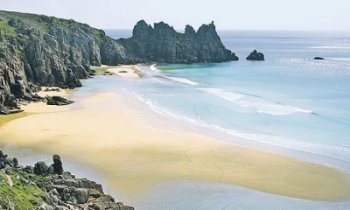


Web: www.nationaltrust.org.uk/visit/cornwall/porthcurno
Web: www.visitcornwall.com/things-to-do/beaches/porthcurno-beach
Beautiful sandy beach in a tiny cove
The beach has remarkably fine white sand formed from ground sea shells. There are magnificent views of the turquoise-tinted bay from the clifftop coastal footpath. One mile along the coast is the Iron Age cliff fort of Treryn Dinas and the Logan Rock, a huge naturally balanced piece of granite weighing 80 tons. In 1824, a group of sailors led by Lieutenant Hugh Calville Goldsmith, nephew of the poet Oliver Goldsmith, and the worse for drink climbed up to Logan Rock armed with crowbars and dislodged it, allowing it to fall down the cliff. Such was the disgust of the local people at this blatant act of vandalism, that they complained to the Admiralty and Goldsmith was ordered to replace the rock at his own expense. It took 60 labourers seven months to replace.
The village is located nine miles to the west of the market town of Penzance and about three miles from Land's End It is accessed from a minor road off the B3315.
The lovely church of St. Levan lies embedded in low green hills at the head of the valley that runs down to Porth Chapel's sandy cove. It is reached from Porthcurno by continuing up a steep hill and along a narrow, no through road. The present church dates in part from the 13th century with 15th century additions. The beach at Porth Chapel can be reached by following the signposted path obliquely opposite the entrance to the car park.
At the southern end of The Valley there is a small hotel, a public car park for about 200 cars, a small seasonal cafe and a public house.
Just to the north of the peninsula is evidence of an Iron Age cliff fort called Treryn Dinas, a scheduled monument comprising about five ramparts, ditches and some evidence of round dwelling huts.
Porthcurno is unusually well known for its size because of its history as a major international submarine communications cable station. In the late 19th century, the remote beach at Porthcurno became internationally famous as the British termination of early submarine telegraph cables. The white pyramid above the village which replaced a cliff-top hut marks where in 1870 the submarine telegraph cable from Brest in France was terminated. Other cables were landed at Porthcurno until there were 14 linking Britain with her Empire and 'PK' became the largest cable station in the world. Porthcurno Telegraph Museum is now housed in the buildings.
The open-air Minack Theatre above the western end of Porthcurno beach is justly famous. It is reached by continuing up the steep hill beyond the entrance to the beach car park. Minack began in 1932 as a makeshift venue for a village play, staged in the cliff-side garden of Miss Rowena Cade. There is now an exhibition centre at the Minack outlining its remarkable history.
Rowena Cade (1893–1983) discovered and bought the Minack headland in the 1920's for £100 and built a house. She later went on to build the Minack Theatre into the cliffs.
Porthgwarra Porthcurno Telegraph Museum The Minack Theatre
Lamorna Cove Land's End Penberth Cove St. Buryan The Coastal Footpath